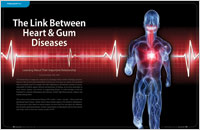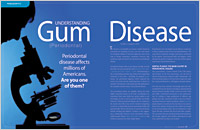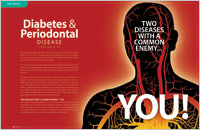What is Periodontal Disease?
Periodontal disease is very common, but it is important to take care of it. Periodontal disease is just a more difficult way to say gum disease.
Stages of Periodontal Disease
Gingivitis is easily reversible, but if not taken care of, you might find yourself dealing with the later stages of periodontal disease which can require more serious treatment than a dental cleaning.
Gingivitis is the early stages of periodontal disease. If you have gingivitis, you may not experience any pain but there are other symptoms you might notice. Gums that bleed when you brush your teeth, slightly puffy gums, and bad breath can all be signs that you have gingivitis. Often, brushing and flossing coupled with regular dental visits are enough to stave off gingivitis. However, if you are following this routine and notice gingivitis appearing it is worth a call to your dentist in order to get their advice on stemming the further progression of periodontal disease. Sometimes, your dentist may need to do a comprehensive cleaning to get rid of the plaque and tartar that can build up on your teeth, allowing bacteria to get into the gums.
Periodontitis follows untreated gingivitis, and according to the American Dental Association (ADA), over 40 percent of Americans over age 30 have chronic periodontitis. In this stage of periodontal disease the plaque gets beneath the gum line, allowing bacteria to fester and causing inflammation, which in turn causes tissue and bone to be destroyed. Because this tissue and bone support your teeth, you might feel your teeth loosening if you have periodontitis. If you notice this occurring, call your dentist. While they may not be able to reverse damage, they can help treat any pain and can take measures to slow the progression of periodontitis.
Common Risk Factors
People who smoke, take certain medications, have diabetes or certain other illnesses are more susceptible to periodontal disease. Additionally, stress can be a contributing factor to periodontal disease because of its overall effect on the body's immune system.
Prevention
Whether you have these risk factors or not, you should be brushing your teeth twice daily, flossing once daily, and seeing your dentist twice a year for cleanings. Those steps, along with any other instructions your dentist has given you, can help keep periodontal disease at bay and your teeth looking and feeling healthy.
Sources:
Related Articles
Related Periodontal (Gum) Disease Articles
 The Link Between Heart & Gum Diseases
The Link Between Heart & Gum Diseases
Inflammation has emerged as a factor that is involved in the process of Cardiovascular Disease (CVD), which commonly results in heart attacks and strokes. While the precise role inflammation plays in causing chronic CVD remains an area of intense current investigation, much more is now known. The good news is that, based on current research, we know that if we can reduce the inflammation caused by periodontal disease, we can reduce the risk for heart attacks and strokes... Read Article
 Understanding Gum (Periodontal) Disease
Understanding Gum (Periodontal) Disease
Have your gums ever bled when you brushed or flossed? This most commonly overlooked simple sign may be the start of silent (periodontal) disease leading to tooth loss. Learn what you can do to prevent this problem and keep your teeth for life... Read Article
 Diabetes & Periodontal Disease
Diabetes & Periodontal Disease
Diabetes and periodontal disease are chronic inflammatory diseases that impact the health of millions of people. What you may not know is that diabetes and periodontal disease can adversely affect each other... Read Article
 Warning Signs of Periodontal (Gum) Disease
Warning Signs of Periodontal (Gum) Disease
This article provides the warning signs of periodontal (gum) disease. Don't wait until it's too late... Read Article


